Early Religious Paintings by Rubens
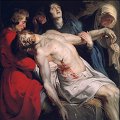 The Flemish and European
Baroque painter Peter Paul Rubens was the
most renowned northern European artist of his day, and is now widely
recognized as one of the foremost painters in Western art history. He
was the proponent of the Baroque style which emphasized
movement, color, and sensuality. By completing
the fusion of the realistic tradition of Flemish painting with the
imaginative freedom and classical themes of Italian Renaissance
painting, he fundamentally revitalized and redirected northern
European painting.
The Flemish and European
Baroque painter Peter Paul Rubens was the
most renowned northern European artist of his day, and is now widely
recognized as one of the foremost painters in Western art history. He
was the proponent of the Baroque style which emphasized
movement, color, and sensuality. By completing
the fusion of the realistic tradition of Flemish painting with the
imaginative freedom and classical themes of Italian Renaissance
painting, he fundamentally revitalized and redirected northern
European painting.
- The Deposition (1602)
- The Flagellation of Christ (1607)
- The Ecstasy of St. Gregory the Great (1608)
- Madonna Adored by Angels (Madonna della Vallicella) (1608)
- Samson and Delilah (1609)
- Raising of the Cross (1610)
- The Entombment (1612)
- Virgin in Adoration before the Christ Child (1615)
- Descent from the Cross (Centre Panel) (1614)
- Descent from the Cross (Right Wing) (1614)
- St. Sebastian (1614)
- The Incredulity of St. Thomas (1615)
- The Virgin and Child with St. Elizabeth and the Infant St. John the Baptist (1615)
- The Stigmatization of St. Francis (1616)
The Deposition (1602)
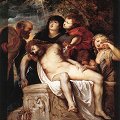 Get
Get  a high-quality picture of
The Deposition for your computer or notebook. ‣
Peter Paul Rubens, the genius of European Baroque, painted his Deposition during his first stay in Rome. Rubens provides us with an extraordinary interpretation of the theme of the incarnation of the divine and human nature of Christ, suspended between death and potential future life. All the shades of the spectrum of light are apparent in the flesh tones, with an opalescence that develops that mother of pearl quality first introduced by Federico Barrocci.
a high-quality picture of
The Deposition for your computer or notebook. ‣
Peter Paul Rubens, the genius of European Baroque, painted his Deposition during his first stay in Rome. Rubens provides us with an extraordinary interpretation of the theme of the incarnation of the divine and human nature of Christ, suspended between death and potential future life. All the shades of the spectrum of light are apparent in the flesh tones, with an opalescence that develops that mother of pearl quality first introduced by Federico Barrocci.
The impact made on Rubens by Roman statuary can be seen in the antique altar with sacrifice scenes, but above all in the strong sculptural high relief of the figures. The dense chromatic texture of the composition owes much Titian's later works, while the airy vibrato and gentle rhythms echo Correggio's achievements. The light unexpectedly bursting through the dark area of the painting provides evidence that Rubens competed in an original way with the chiaroscuro experiments of his contemporary Caravaggio.
The Flagellation of Christ (1607)
 Get
Get  a high-quality picture of
The Flagellation of Christ for your computer or notebook. ‣
The essence of Rubens's exuberant style can be found in the oil sketches he made when preparing his monumental paintings. In the Flagellation of Christ - a sketch for the painting in Antwerp's Church of St Paul - he explores the contrast between the physical violence of the torturers and Christ's bent body. The figures fill virtually the entire space and stand out for their sculptural power.
a high-quality picture of
The Flagellation of Christ for your computer or notebook. ‣
The essence of Rubens's exuberant style can be found in the oil sketches he made when preparing his monumental paintings. In the Flagellation of Christ - a sketch for the painting in Antwerp's Church of St Paul - he explores the contrast between the physical violence of the torturers and Christ's bent body. The figures fill virtually the entire space and stand out for their sculptural power.
The Ecstasy of St. Gregory the Great (1608)
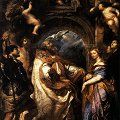 Get
Get  a high-quality picture of
The Ecstasy of St. Gregory the Great for your computer or notebook. ‣
At the end of 1605 Rubens settled in Rome. Of great significance were his commissions for the Oratorians, who were, with the Jesuits, one of the most important new orders of the Counter-Reformation. In these altarpieces of Rubens's later period there is a strong affinity with the work of Correggio, another painter of the High Renaissance, who exercised an important influence on the emergence of the Baroque style through his softer modelling and his emotionally charged expressively. That was particularly the case in contemporary Rome, where the style of the leading painters such as Federico Barocci and Annibale Carracci was based in part on Correggio.
a high-quality picture of
The Ecstasy of St. Gregory the Great for your computer or notebook. ‣
At the end of 1605 Rubens settled in Rome. Of great significance were his commissions for the Oratorians, who were, with the Jesuits, one of the most important new orders of the Counter-Reformation. In these altarpieces of Rubens's later period there is a strong affinity with the work of Correggio, another painter of the High Renaissance, who exercised an important influence on the emergence of the Baroque style through his softer modelling and his emotionally charged expressively. That was particularly the case in contemporary Rome, where the style of the leading painters such as Federico Barocci and Annibale Carracci was based in part on Correggio.
The Ecstasy of St Gregory the Great was commissioned for the high-altar painting of the Oratorians' main church, Santa Maria Vallicella. The compositional structure and the emotionally charged facial expressions and details in movement in Rubens's first 'modello' for this altarpiece (Staatliche Museen, Berlin) is inspired by similar altar compositions by Correggio. In the definitive version the construction, influenced by Raphael and antique sculpture, is stronger and more classicist. This painting is without doubt the zenith of the artistic output of Rubens's Italian years. This majestic veneration of the saints is also one of the most manifest expressions of Counter-Reformation triumphalism in the city of its birth.
Rubens considered this commission as the confirmation of his reputation as a painter in Rome. Yet the picture was not hung in the place for which it was intended, because it reflected the light entering the church too strongly. For this reason the canvas was replaced by a new version on slate. This was quite different from the first painting; its composition was divided over three separate panels. This work, still in its original place in Santa Maria Vallicella, was ready in autumn 1608. Immediately afterwards Rubens returned to Antwerp. He took the rejected canvas with him and placed it above the tomb of his mother, Maria Pijpelinckx, who had died while he was on his way home.
Madonna Adored by Angels (Madonna della Vallicella) (1608)
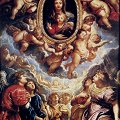 Get
Get  a high-quality picture of
Madonna Adored by Angels (Madonna della Vallicella) for your computer or notebook. ‣
The Oratorians commissioned a painting from Rubens for the high-altar of their main church, Santa Maria Vallicella. Rubens painted the Ecstasy of St Gregory the Great, however, it was rejected on the ground that it reflected the light entering the church too strongly. For this reason the canvas was replaced by a new version on slate. This was quite different from the first painting; its composition was divided over three separate panels. This work, still in its original place in Santa Maria Vallicella, was ready in autumn 1608.
a high-quality picture of
Madonna Adored by Angels (Madonna della Vallicella) for your computer or notebook. ‣
The Oratorians commissioned a painting from Rubens for the high-altar of their main church, Santa Maria Vallicella. Rubens painted the Ecstasy of St Gregory the Great, however, it was rejected on the ground that it reflected the light entering the church too strongly. For this reason the canvas was replaced by a new version on slate. This was quite different from the first painting; its composition was divided over three separate panels. This work, still in its original place in Santa Maria Vallicella, was ready in autumn 1608.
Samson and Delilah (1609)
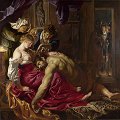 Get
Get  a high-quality picture of
Samson and Delilah for your computer or notebook. ‣
In 1608 Rubens hastily returned home to Antwerp after an absence of eight years in Italy, in a vain attempt to reach the bedside of his dying mother. His arrival in the city virtually coincided with the truce between Spanish Flanders and the Dutch United Provinces, and he was quickly appointed official painter to the Regents of the Southern Netherlands, the Archduke Albert and the Archduchess Isabella, with leave to remain domiciled in Antwerp. He was never to return to Italy, although he was irrevocably marked by his study of ancient Greco-Roman and Italian Renaissance art. In Antwerp he proceeded to work towards the reconstruction of his war-torn country and to establish himself as a leading figure in its artistic and intellectual life.
a high-quality picture of
Samson and Delilah for your computer or notebook. ‣
In 1608 Rubens hastily returned home to Antwerp after an absence of eight years in Italy, in a vain attempt to reach the bedside of his dying mother. His arrival in the city virtually coincided with the truce between Spanish Flanders and the Dutch United Provinces, and he was quickly appointed official painter to the Regents of the Southern Netherlands, the Archduke Albert and the Archduchess Isabella, with leave to remain domiciled in Antwerp. He was never to return to Italy, although he was irrevocably marked by his study of ancient Greco-Roman and Italian Renaissance art. In Antwerp he proceeded to work towards the reconstruction of his war-torn country and to establish himself as a leading figure in its artistic and intellectual life.
One of his closest friends and patrons at this time was the wealthy and influential alderman Nicolaas Rockocx, for whom Rubens painted Samson and Delilah to hang in a prominent position over the mantelpiece of his `great saloon' in Antwerp. When the picture was hung at its original height of just over two metres (seven feet) some years ago in an exhibition at the National Gallery, it became clear how nicely Rubens had calculated the angle of vision. The surface of Delilah's bed receded to a properly horizontal plane, with the space of the room leading convincingly back to the wall and the door through which the Philistine soldiers enter to capture the hapless Jewish hero. To the multiple light sources in this room, for which Rubens was indebted to his friend Elsheimer - the flaming brazier, the candle held by the old procuress and the torch of the Philistines - we must add in our mind's eye a fire blazing in the fireplace below, highlighting the saffron satin throw behind Delilah and the patterned Oriental rug, and casting warm reflections in the shadows of the skin tones and the white drapery, where the coarse brown hatching of the underpaint is left uncovered or barely veiled.
The story of Samson's fatal passion for Delilah is told in the Old Testament (Judges 16:4-6, 16-21). Bribed by his Philistine enemies, she cozens Samson into revealing the source of his supernatural strength: his uncut hair. As he lies asleep in her lap during a night of love, she calls in a barber to cut off `the seven locks of his head'. The tale of a man brought low by lust for a woman was often treated in sixteenth-century Netherlandish art, and Rubens follows this Northern tradition by introducing a procuress, who does not appear in the Bible. Her profile juxtaposed with that of the youthful harlot both reveals her own past and suggests Delilah's future. At the same time, the painting is rich in Italian memories, not least in the ample scale of its life-size foreground figures, accommodated on the panel only by being shown reclining. A statue of Venus and Cupid presides over the erotic scene. Brawny Samson derives from antique sculpture and from Michelangelo; Delilah's pose is that of Michelangelo's Leda and Night in reverse. In Delilah's breast band Rubens draws on Roman marbles, but following his own maxim translates marble into soft and yielding flesh - some of the fleshiest ever painted.
Ultimately, however, this sumptuous picture is entirely original, and nowhere is this more apparent than in the incongruously dainty professional gesture of the barber and in Delilah's ambiguous expression, compounded of sensuality, triumph and pity.
Raising of the Cross (1610)
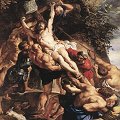 Get
Get  a high-quality picture of
Raising of the Cross for your computer or notebook. ‣
Rubens painted the triptych for the high altar of Antwerp's church of St Walpurgis, which was demolished in 1817. That explains the inclusion of Amand, Walpurgis and Eligius on the back side of the wings.
a high-quality picture of
Raising of the Cross for your computer or notebook. ‣
Rubens painted the triptych for the high altar of Antwerp's church of St Walpurgis, which was demolished in 1817. That explains the inclusion of Amand, Walpurgis and Eligius on the back side of the wings.
The triptych marked Rubens' sensational introduction of the Baroque style into Northern art. The diagonal composition is full of dynamism and animated colour. The artist had just returned from Italy, with the memory of Michelangelo, Caravaggio and Venetian painting still fresh in his mind. The Raising of the Cross is the perfect summation of the unruly bravura that marked his first years in Antwerp.
In the centre nine executioners strain with all their might to raise the cross from which Christ's pale body hangs. The dramatic action is witnessed from the left by St John, the Virgin Mary and a group of weeping women and children. On the right, a Roman officer watches on horseback while soldiers in the background are crucifying the two thieves. In other words, the subject is spread across all three panels. The outside of the wings shows Saints Amand, Walpurgis, Eligius and Catherine of Alexandria.
The painting was confiscated by the French in 1794 and taken to Paris. It was returned to Antwerp in 1815, following the defeat of Napoleon, and installed in the church of Our Lady.
During restoration in the 1980s, successive layers of varnish, which had form an even grey veil over the painting, were removed. The burgeoning talent of the confident young Rubens is more clearly visible now in the intense emotion of the figures, the contrasting lighting, the glow of the labouring bodies and the gleam of the armour and costly robes.
The Entombment (1612)
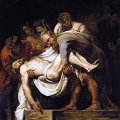 Get
Get  a high-quality picture of
The Entombment for your computer or notebook. ‣
In 1611, Rubens returned to copying, his original this time the artist who had most impressed him after Titian: his version of the latter's Entombment after Caravaggio is now in the Canadian National Gallery.
a high-quality picture of
The Entombment for your computer or notebook. ‣
In 1611, Rubens returned to copying, his original this time the artist who had most impressed him after Titian: his version of the latter's Entombment after Caravaggio is now in the Canadian National Gallery.
Virgin in Adoration before the Christ Child (1615)
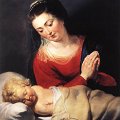 Get
Get  a high-quality picture of
Virgin in Adoration before the Christ Child for your computer or notebook. ‣
The Virgin in Adoration before the Christ Child and Christ on the Cross. The Virgin in Adoration before the Christ Child, an intimate, homely scene which forges an emotional link between maternal love and piety, dates from c. 1615 and is typical of Rubens' work around this time, in the balance and clarity of the composition, the sculptural proportions of the figures and the somewhat cool use of colour.
a high-quality picture of
Virgin in Adoration before the Christ Child for your computer or notebook. ‣
The Virgin in Adoration before the Christ Child and Christ on the Cross. The Virgin in Adoration before the Christ Child, an intimate, homely scene which forges an emotional link between maternal love and piety, dates from c. 1615 and is typical of Rubens' work around this time, in the balance and clarity of the composition, the sculptural proportions of the figures and the somewhat cool use of colour.
Descent from the Cross (Centre Panel) (1614)
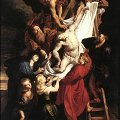 Get
Get  a high-quality picture of
Descent from the Cross (Centre Panel) for your computer or notebook. ‣
The centre panel of the great triptych shows the Descent from the Cross against a dark sky. Several men - Joseph of Arimathea, Nicodemus, St John and two servants - carefully lower the body of Christ in a brilliant white shroud. They are assisted by several women, including Jesus' mother. Christ's foot rests on the shoulder of Mary Magdalene, who dried his feet with her hair.
a high-quality picture of
Descent from the Cross (Centre Panel) for your computer or notebook. ‣
The centre panel of the great triptych shows the Descent from the Cross against a dark sky. Several men - Joseph of Arimathea, Nicodemus, St John and two servants - carefully lower the body of Christ in a brilliant white shroud. They are assisted by several women, including Jesus' mother. Christ's foot rests on the shoulder of Mary Magdalene, who dried his feet with her hair.
Descent from the Cross (Right Wing) (1614)
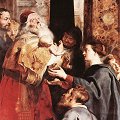 Get
Get  a high-quality picture of
Descent from the Cross (Right Wing) for your computer or notebook. ‣
The right wing of the great triptych of the Descent from the Cross is devoted to the presentation of the Infant Christ in the Temple at Jerusalem. The elderly Simeon holds the Child in his arms while the prophetess Anna, located in the shadows between Simeon and Mary, looks on joyfully. Joseph, who has brought two sacrificial doves with him, kneels down respectfully. The onlooker on the left edge of this splendid temple interior is Nicolaas Rockox, a friend of Rubens and a prominent figure in Antwerp.
a high-quality picture of
Descent from the Cross (Right Wing) for your computer or notebook. ‣
The right wing of the great triptych of the Descent from the Cross is devoted to the presentation of the Infant Christ in the Temple at Jerusalem. The elderly Simeon holds the Child in his arms while the prophetess Anna, located in the shadows between Simeon and Mary, looks on joyfully. Joseph, who has brought two sacrificial doves with him, kneels down respectfully. The onlooker on the left edge of this splendid temple interior is Nicolaas Rockox, a friend of Rubens and a prominent figure in Antwerp.
St. Sebastian (1614)
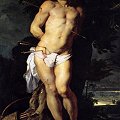 Get
Get  a high-quality picture of
St. Sebastian for your computer or notebook. ‣
After Sebastian had survived execution by bowmen and protested publicly against the persecution of the Christians, the Roman Emperor had him slain. The miraculous deliverance of the saint, transfixed by arrows, was regarded even in early times as a parallel to the resurrection of Christ. The figure of the martyr as portrayed by Rubens is also intended to recall the Crucifixion. Bound to a tree, his eyes turned upwards to heaven, he seems only slightly affected by the bleeding wounds. The way in which the bound man twists his body may be taken as a sign of pain but this does not lessen its beauty, which is that of a hero of antiquity.
a high-quality picture of
St. Sebastian for your computer or notebook. ‣
After Sebastian had survived execution by bowmen and protested publicly against the persecution of the Christians, the Roman Emperor had him slain. The miraculous deliverance of the saint, transfixed by arrows, was regarded even in early times as a parallel to the resurrection of Christ. The figure of the martyr as portrayed by Rubens is also intended to recall the Crucifixion. Bound to a tree, his eyes turned upwards to heaven, he seems only slightly affected by the bleeding wounds. The way in which the bound man twists his body may be taken as a sign of pain but this does not lessen its beauty, which is that of a hero of antiquity.
In his Sebastian picture, which must have been painted c. 1614, Rubens realized many of the impressions he had gained during his eight years in Italy (1600-08). The sculptural, corporeal quality of the saint's figure reminds one both of the antique and of Michelangelo's works. The contrasting light and shade and the realistic treatment of detail were touches that Rubens had learned from Caravaggio. But in combining the statuesque figure with the atmosphere of an evening landscape, the Flemish painter surpassed his Roman master. Here the tragedy of the event finds adequate expression in the language of nature.
In a letter of 1618 to Sir Dudley Carlton, Rubens mentions a selection of his own paintings, which he had kept back in his house 'for his own pleasure' and which he was prepared to exchange for works of art in the possession of the English diplomat. Among the pictures included in the painter's offer is a 'naked Saint Sebastian by my hand', in all probability the one now in Berlin.
The Incredulity of St. Thomas (1615)
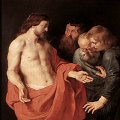 Get
Get  a high-quality picture of
The Incredulity of St. Thomas for your computer or notebook. ‣
After becoming a master in the Antwerp Guild of Saint Luke in 1598, Rubens left for Italy in 1600, where he spent eight years and visited all the major cities. He spoke Italian, knew Latin, and was familiar with the great writers of Antiquity. His period in Italy allowed him to study Antique works of art and the masterpieces of the Italian Renaissance at first hand. After returning to Antwerp in 1608, he was appointed court painter to Archduke Albert and the Infanta Isabella in 1609. He was given a great many commissions. Between 1613 and 1615, for instance, he painted the triptych The Incredulity of Saint Thomas for Nicolaas Rockox, which was destined for the chapel containing his tomb in the Franciscan church in Antwerp. Rockox, a famous Antwerp patrician and humanist, who was mayor of the city on a number of occasions, is shown in the left-hand panel, with his wife on the right.
a high-quality picture of
The Incredulity of St. Thomas for your computer or notebook. ‣
After becoming a master in the Antwerp Guild of Saint Luke in 1598, Rubens left for Italy in 1600, where he spent eight years and visited all the major cities. He spoke Italian, knew Latin, and was familiar with the great writers of Antiquity. His period in Italy allowed him to study Antique works of art and the masterpieces of the Italian Renaissance at first hand. After returning to Antwerp in 1608, he was appointed court painter to Archduke Albert and the Infanta Isabella in 1609. He was given a great many commissions. Between 1613 and 1615, for instance, he painted the triptych The Incredulity of Saint Thomas for Nicolaas Rockox, which was destined for the chapel containing his tomb in the Franciscan church in Antwerp. Rockox, a famous Antwerp patrician and humanist, who was mayor of the city on a number of occasions, is shown in the left-hand panel, with his wife on the right.
The Virgin and Child with St. Elizabeth and the Infant St. John the Baptist (1615)
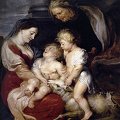 Get
Get  a high-quality picture of
The Virgin and Child with St. Elizabeth and the Infant St. John the Baptist for your computer or notebook. ‣
This group provides the opportunity to the artist to paint flesh tones, from the Virgin's delicate pallor to the glowing pinks of the children and the more weather-beaten face of the elderly St Elizabeth. The vitality and life of Rubens's art is here reflected in the composition and the poses of the figures, as well as in the brilliant colouring of the clothes and skin tones. The group is balanced by the coldness of the background, which is painted in subtle gradations of blues and greys.
a high-quality picture of
The Virgin and Child with St. Elizabeth and the Infant St. John the Baptist for your computer or notebook. ‣
This group provides the opportunity to the artist to paint flesh tones, from the Virgin's delicate pallor to the glowing pinks of the children and the more weather-beaten face of the elderly St Elizabeth. The vitality and life of Rubens's art is here reflected in the composition and the poses of the figures, as well as in the brilliant colouring of the clothes and skin tones. The group is balanced by the coldness of the background, which is painted in subtle gradations of blues and greys.
The Stigmatization of St. Francis (1616)
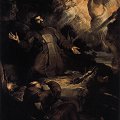 Get
Get  a high-quality picture of
The Stigmatization of St. Francis for your computer or notebook. ‣
This picture was commissioned for the high altar of the Capuchin Church in Cologne. The high format of the painting makes it likely to have been one panel of a fixed retable - originally an Italian feature adopted for altars north of the Alps particularly during the Baroque period. The style of the altarpiece, with its emphatic single figure, was developed further by Rubens shortly afterwards in his designs for the altarpieces of St Ignatius and St Francis Xavier for the Jesuit church in Antwerp, and was highly influential.
a high-quality picture of
The Stigmatization of St. Francis for your computer or notebook. ‣
This picture was commissioned for the high altar of the Capuchin Church in Cologne. The high format of the painting makes it likely to have been one panel of a fixed retable - originally an Italian feature adopted for altars north of the Alps particularly during the Baroque period. The style of the altarpiece, with its emphatic single figure, was developed further by Rubens shortly afterwards in his designs for the altarpieces of St Ignatius and St Francis Xavier for the Jesuit church in Antwerp, and was highly influential.
Peter Paul Rubens Art

|
|
More
Articles
 Art Encyclopedia A world history of art in articles.
Art Encyclopedia A world history of art in articles.
Baroque
Peter Paul Rubens
Art and life. Biography.
Early mythological paintings.
Late mythological paintings.
Early religious paintings.
Late religious paintings.
Portraits.
Landscapes.
Art
 Art Wallpapers Art image collections for your desktop.
Art Wallpapers Art image collections for your desktop.
Caravaggio Art, $25
(100 pictures)
Rubens Art, $29
(200 pictures)
Rembrandt Art, $25
(160 pictures)

